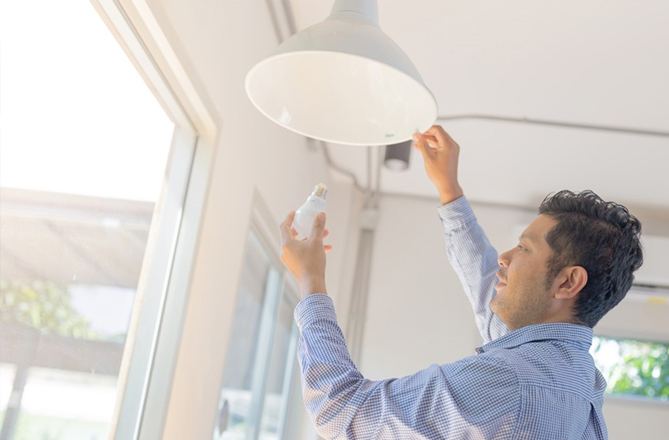Energy Saving Tips for Your Home
When it comes to energy, small changes can add up to big savings. Here, we offer ways you can reduce your usage year-round.
- Turn Off Power Sources. Many electronics use power when in standby mode, or even when turned off. Plug them into a power strip and turn it off when not in use.
- Seal Up and Save. Use weather stripping or caulk to seal cracks and prevent drafts in windows and doorframes and don’t forget to install draft guards beneath doors.
- Smart Thermostats. Use a smart thermostat’s pre-programmed temperature settings and vacation settings to lower your energy bill. The PSE&G Marketplace offers smart thermostats at discounted prices. To learn more, or to make a purchase, click here.
- Invest in Your Home’s Energy Efficiency. Consider replacing old, drafty windows with new, energy-efficient models. If shopping for appliances, look for ENERGY STAR® models that will save you energy and money.
- Replace Air Filters Regularly. Clogged and dirty filters can significantly reduce efficiency in your heating and cooling systems.
- Use Timers and Motion Detectors. Indoor and outdoor timers and motion detectors are a great way to make sure you only use lighting when you need it.
- Give Your Refrigerator “Breathing Room.” Clean the coils and don’t set the temperature too low. Keep the refrigerator between 38⁰ F and 42⁰ F and the freezer between 0⁰ and 5⁰ F.
- Wash Full Loads of Laundry Using Cold Water. Modern detergents work well in cold water, and about 90 percent of the energy used by clothes washers goes to water heating. Use your clothes dryer for consecutive loads. The built-up heat means less energy spent.
- When Purchasing A New Washing Machine, Check the Modified Energy Factor (MEF) Information on the Label. The higher the MEF, the more efficient the clothes washer.
- Use Glass Baking Dishes in the Oven When Possible. Glass retains heat better than metal pans, so it helps food cook faster. With glass baking dishes, you typically can reduce your oven temperature by about 25⁰ F.
- Operate Your Dishwasher with Full Loads, and Air-Dry Dishes on the Energy Saver Setting. If the manufacturer's instructions permit, open the dishwasher door at the end of the last rinse cycle, rather than using the drying cycle.
- Use Pots and Pans That Are Properly Sized to Your Stove's Burners. Using a small pan on a large burner wastes energy and can be a safety hazard.
- Lower the Temperature Setting. Home heating is the largest user of energy and offers the greatest opportunity for savings. Set your programmable thermostat as low as is comfortable in the winter and lower the set point when you’re sleeping or away from home.
- Close Fireplace Dampers When Not in Use. Stop warm air from escaping through chimneys.
- Move Furniture and Drapes Away from Heat Sources. Remove furniture or items which block vents. Open any register or baseboard dampers.
- Use Ceiling Fans to Circulate Warm Air. Make sure that the fan blades are slowly spinning clockwise to draw cold air up and force warmer air down.
- Cover Window Air Conditioners. Remove or cover window air conditioners to reduce drafts.
- Replace Old Windows. Replace old, drafty windows with new, energy-efficient windows for added insulation and less heat loss.
- Seal Basement Windows and Doors. Use weather-stripping or caulk to seal up cracks and prevent drafts in windows and doorframes. Beneath doors, install draft guards available at hardware stores.
- Raise the Temperature Setting. Set your programmable thermostat as high as is comfortable in the summer and raise the set point when you’re sleeping or away from home.
- Close Doors and Vents. If you have central air conditioning, close doors and vents to unused rooms.
- Fans. Adjust ceiling fans to spin counterclockwise to pull air down from the ceiling and create a cooling breeze. Install whole-house fans to bring in cooler nighttime air, and let Mother Nature cool your house.
- Seal Holes and Cracks around Windows and Doors. Use weather-stripping or caulk to seal cracks to keep cool air in and warm air out, and don’t forget to install draft guards beneath doors.
- Turn Off Power Sources. Many electronics use power when in standby mode, or even when turned off. Plug them into a power strip and turn it off when not in use.
- Use Timers and Motion Detectors. For indoor and outdoor lighting, timers and motion detectors are a great way to make sure you only use lighting when you need it.
- Replace Old Appliances. Replacing older, inefficient appliances with ENERGY STAR® appliances will save energy and help to lower your bill.
- Close Blinds, Shades and Drapes. Close blinds, shades and draperies facing the sun to keep out the sun's heat and help fans and air conditioners cool more efficiently.
























